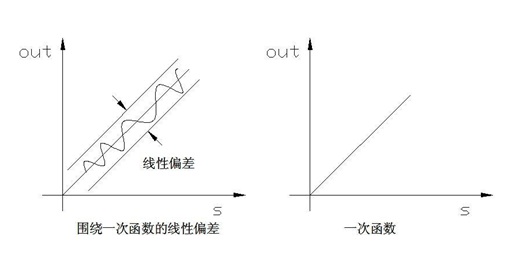Classify
Contact

Hotline:
0750-6163878
( Ms Zhang )
Phone: 18929003382
Fax: 0750-6703782
Address: East Industrial Zone, Huicheng Town, Xinhui District, Jiangmen city
URL: zhuyuan.net.cn
Nonlinearity, linearity (nonlinear error)
Linearity (also known as nonlinear error): refers to the degree that the actual relationship curve between output and input deviates from its fitting line.
The magnetic ruler adopts the least square method to determine the fitting straight line, and the linearity level of the magnetic ruler can be maintained within the service life of the equipment.


System resolution

linear
When the relationship between input and output is a linear function, its characteristic curve is a straight line. It can be considered that the output changes linearly, and its slope represents the sensitivity of the equipment.
The input quantity of the magnetic ruler is the position value of the positioning magnet, and the output quantity is the corresponding electrical signal.
Resolution
Resolution: refers to the minimum change of the measured input quantity that can be detected by the magnetic ruler within the specified measurement range, that is, the resolution of small changes in the input quantity.
Resolution: the percentage of resolution relative to full-scale input.
accuracy
It refers to the consistency between the measured indicated value and the measured (agreed) true value.
The accuracy of the sensor is a comprehensive index, which refers to the root mean square error of non linear, repeatability and hysteresis.

sensitivity
The sensitivity of a device is equal to the ratio of the output increment to the corresponding input increment.
Update time, sampling frequency
Update time (sampling frequency): refers to the periodic frequency of data refresh and sampling processing within the magnetic ruler, which is equal to the number of input quantity detection per second.
For some equipment that use magnetic ruler to measure fast moving parts, it is necessary to have a high sampling frequency to ensure the real-time performance of the detection data.
Repeatability, repeatability error
Repeatability: under the same working conditions, the mutual consistency between the output quantities measured continuously for many times from the same direction to the same position.
Repeatability error: the random error obtained by continuous multiple measurements from the same direction and the same position under the same working conditions. The repeatability error is affected by the lag and resolution of the equipment.
Hysteresis (hysteresis)
Hysteresis refers to the degree to which the output does not coincide with the input characteristic curve in the positive (input increase) and negative (input decrease) strokes.
Taking the magnetic ruler as an example, suppose that the magnetic ring moves to the same position in the positive and negative directions respectively, but the electrical signals output twice are not consistent, and the difference between the inconsistent outputs is the lag.
System resolution
It refers to the resolution setting parameters matching the magnetic ruler with the upper computer, control system, secondary instrument and other equipment and instruments.
If the system resolution of the magnetic ruler is inconsistent with the set value of the equipment, the data display will be abnormal, and the equipment will not work normally.
Effective range
It refers to the algebraic difference between the upper limit value and the lower limit value of the measurement range. The effective range of the magnetic ruler product must be shorter than the total length of the equipment.
zero point
It refers to the initial input position in the effective range of the magnetic ruler. DL series magnetic ruler can be set arbitrarily in effective range.
Full scale
It refers to the position of the ending input quantity in the effective range of the magnetic ruler.
Dead zone
For magnetic ruler products, the blind area refers to the measuring rod area that does not respond or has response to the input change but fails to meet the specified accuracy (precision) requirements, that is, the measuring rod part other than effective range.